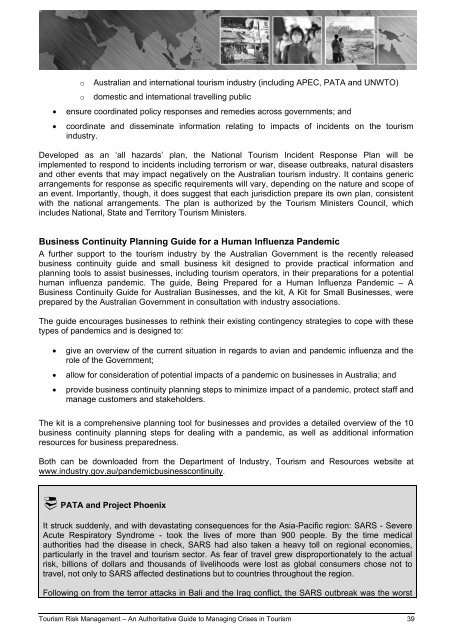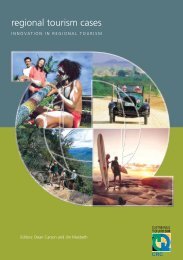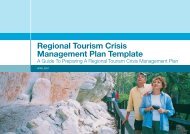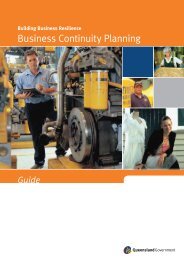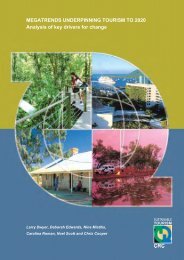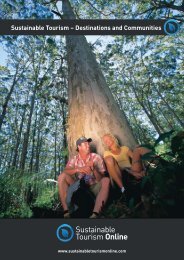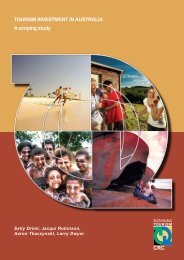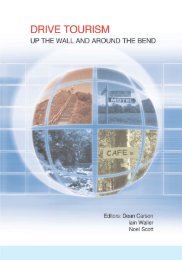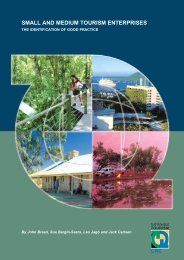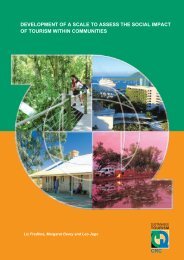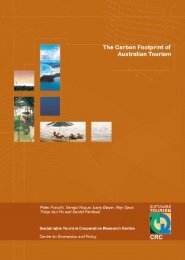Tourism Risk Management - Sustainable Tourism Online
Tourism Risk Management - Sustainable Tourism Online
Tourism Risk Management - Sustainable Tourism Online
Create successful ePaper yourself
Turn your PDF publications into a flip-book with our unique Google optimized e-Paper software.
o<br />
Australian and international tourism industry (including APEC, PATA and UNWTO)<br />
o domestic and international travelling public<br />
• ensure coordinated policy responses and remedies across governments; and<br />
• coordinate and disseminate information relating to impacts of incidents on the tourism<br />
industry.<br />
Developed as an ‘all hazards’ plan, the National <strong>Tourism</strong> Incident Response Plan will be<br />
implemented to respond to incidents including terrorism or war, disease outbreaks, natural disasters<br />
and other events that may impact negatively on the Australian tourism industry. It contains generic<br />
arrangements for response as specific requirements will vary, depending on the nature and scope of<br />
an event. Importantly, though, it does suggest that each jurisdiction prepare its own plan, consistent<br />
with the national arrangements. The plan is authorized by the <strong>Tourism</strong> Ministers Council, which<br />
includes National, State and Territory <strong>Tourism</strong> Ministers.<br />
Business Continuity Planning Guide for a Human Influenza Pandemic<br />
A further support to the tourism industry by the Australian Government is the recently released<br />
business continuity guide and small business kit designed to provide practical information and<br />
planning tools to assist businesses, including tourism operators, in their preparations for a potential<br />
human influenza pandemic. The guide, Being Prepared for a Human Influenza Pandemic – A<br />
Business Continuity Guide for Australian Businesses, and the kit, A Kit for Small Businesses, were<br />
prepared by the Australian Government in consultation with industry associations.<br />
The guide encourages businesses to rethink their existing contingency strategies to cope with these<br />
types of pandemics and is designed to:<br />
• give an overview of the current situation in regards to avian and pandemic influenza and the<br />
role of the Government;<br />
• allow for consideration of potential impacts of a pandemic on businesses in Australia; and<br />
• provide business continuity planning steps to minimize impact of a pandemic, protect staff and<br />
manage customers and stakeholders.<br />
The kit is a comprehensive planning tool for businesses and provides a detailed overview of the 10<br />
business continuity planning steps for dealing with a pandemic, as well as additional information<br />
resources for business preparedness.<br />
Both can be downloaded from the Department of Industry, <strong>Tourism</strong> and Resources website at<br />
www.industry.gov.au/pandemicbusinesscontinuity.<br />
PATA and Project Phoenix<br />
It struck suddenly, and with devastating consequences for the Asia-Pacific region: SARS - Severe<br />
Acute Respiratory Syndrome - took the lives of more than 900 people. By the time medical<br />
authorities had the disease in check, SARS had also taken a heavy toll on regional economies,<br />
particularly in the travel and tourism sector. As fear of travel grew disproportionately to the actual<br />
risk, billions of dollars and thousands of livelihoods were lost as global consumers chose not to<br />
travel, not only to SARS affected destinations but to countries throughout the region.<br />
Following on from the terror attacks in Bali and the Iraq conflict, the SARS outbreak was the worst<br />
<strong>Tourism</strong> <strong>Risk</strong> <strong>Management</strong> – An Authoritative Guide to Managing Crises in <strong>Tourism</strong> 39


